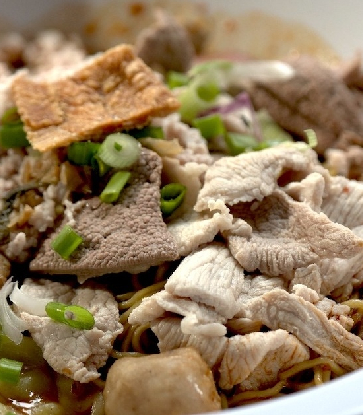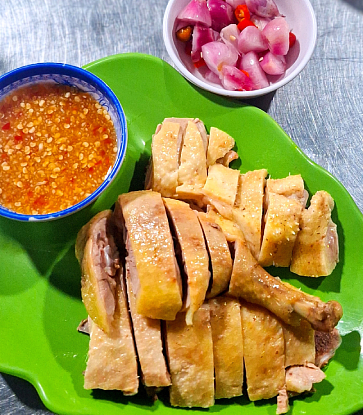Ask for additional herbs in a Hanoi pho (phở) restaurant and expect a dismissive wave of the hand. Ask for hoisin sauce — a sweet, sticky, soybean-based condiment popular in Ho Chi Minh City — and risk causing offence.
In Hanoi, a bowl of pho only contains a handful of elements: flat rice noodles, a clear broth, thin slices of chicken or beef (never both), spring onions, and coriander. You may enrich your meal, but only with a limited selection of ingredients: lime or vinegar, pickled garlic, and fresh chilli. To request anything more is an insult to the chef, who has spent the better part of a day perfecting the broth.
By contrast, Ho Chi Minh City serves a souped-up pho. Down south, in addition to the essential elements of Hanoi’s pho, the dish might arrive at your table topped with meatballs, red or white onions, and a mound of fresh green herbs. The broth tends to be darker, cloudier, and sweeter. The most glaring difference, though, is in the sauces and sides.

“You can spot the difference immediately,” says Luu Dong, head chef at Tre Dining, a restaurant in Ho Chi Minh City recommended in the MICHELIN Guide Hanoi & Ho Chi Minh City 2023 that adapts and modernises traditional Vietnamese recipes. Born in Nam Dinh, trained in Hanoi (the two birthplaces of pho), and working in Ho Chi Minh City, Chef Dong has had time to mull over the regional rivalry that colours his country’s national dish. While the accompaniments served with northern pho tend to be meagre, says Dong, southern adjuncts include hoisin sauce, sweetened chilli sauce, beansprouts, and many more herbs, including Thai basil, culantro and spearmint.
But what caused the rift?

Back to Basics
Vietnamese mythology is testament to the country’s fondness of a good origin story. One legend tells that the Vietnamese are the product of an ill-fated union between a warrior king and a mountain fairy. Another professes that a scorned water god invented flooding to exact revenge after he was denied an earthly princess. Vietnam’s most well-known just-so story recounts how Halong Bay got its islands: to protect the country from seafaring invaders, ethereal dragons spat a protective barrier of pearl and jade into an exposed gulf.
The origin story of pho may not be seasoned with fantastical characters, but it still offers plenty of zest. “It seems that pho is inspired by Chinese or French cuisine,” says Vu Van Hoi, head chef of The East, a contemporary Vietnamese eatery with Bib Gourmand recognition tucked away in Hanoi’s Old Quarter, “but nobody can really be sure.” In fact, it was probably inspired by both.

Phở bò (beef pho) predates phở gà (chicken pho) and probably didn’t come about until the early 20th century, when Vietnam was under French colonial rule. Before the French, the Vietnamese eschewed beef. They preferred to draw flavour from pork, poultry, fish, seafood, and sometimes buffalo. Cows existed in Vietnam, of course, but they ploughed the land instead of gracing the plate.
Hanoi was the capital of Indochina, which encompassed present-day Vietnam, Laos, and Cambodia. By the beginning of the 20th century, the French were bulldozing Vietnamese settlements to make way for broad boulevards and flamboyant public buildings. Their dream was to make their eastern metropolis as Parisian as possible. This remodelling extended to cuisine: cafes, boulangeries, and ice cream parlours also popped up across the city. French chefs cooked up classic dishes from home, such as steak frites (steak and fries) and pot-au-feu (slow-cooked beef and vegetables).

Entrepreneurial Vietnamese butchers were quick to respond to the surge in demand for beef. They began slaughtering cows that were working the fields and selling the meat for juicy profits. The bones were flogged to street food vendors, who experimented to find the best way to extract flavour from this novel ingredient. The Vietnamese had used carcass bones to boil broth for centuries, and they quickly developed a method that pleased local tastes.

They combined the broth with rice noodles, an import from Southern China, and started serving the dish in Hanoi’s old quarter, the city’s traditional food hub. As Peter Cuong Franklin, founder and head chef at the one MICHELIN Starred Ănăn Saigon in Ho Chi Minh City puts it, “One can picture the dish as having French ‘blood’, a Chinese ‘body’, and imbued with Vietnamese soul and character.”

Parting Ways
In 1954, following the French exit from Vietnam, the country split in two. Many North Vietnamese moved to South Vietnam, and they brought pho with them. The northerners set up shop in Saigon (now Ho Chi Minh City) but found that southern tastes were rather different. Southerners were more liberal with their use of fresh, uncooked herbs, which grew in abundance on the city’s doorstep in the Mekong Delta. Furthermore, Southern dishes chimed with the sweeter flavours from elsewhere in Southeast Asia.
The broth in southern pho evolved to become a little more like the sweeter southern noodle soup dishes, like hủ tiếu. Importantly, Saigon was a city of immigrants, so pho shops allowed their customers to match their regional tastes with a spread of sauces and sides. Northerners might add little to their bowl. Diners from Central Vietnam, where the cuisine tends to be hot, might add chilli. Southerners could stuff their bowl with hoisin sauce and fresh green herbs.

Phở the Future
Vietnam reunified in 1975, but Hanoi, Ho Chi Minh City, and their respective pho restaurants have maintained many of their differences. In Vietnam’s bastion of tradition, Hanoi, pho is simple, austere, and perhaps not very different from the last century. In Ho Chi Minh City, the country’s trend-setting economic capital, pho is dynamic, adaptable, and served with myriad sides.
Even today, Ho Chi Minh City continues to push boundaries.
At Tre Dining, Chef Dong developed a rich and buttery foie gras pho. Chef Franklin of Ănăn Saigon has gone even further, with a pho that features a truffle-infused consommé, a molecular pho that presents all the flavours of the noodle soup dish in one bite, and his headline-grabbing $100 pho, an indulgent feast. Chef Franklin is so enamoured with the dish that he’s opening Pot Au Phở, another restaurant above Ănăn Saigon, in August 2023. “Pot Au Phở is my homage to pho,” he says. “It’s where we synthesise everything we do with pho in one place.”
In many ways, things are as they were half a century ago: while Hanoi safeguards tradition, Ho Chi Minh City strives to innovate. All in a bowl.





















